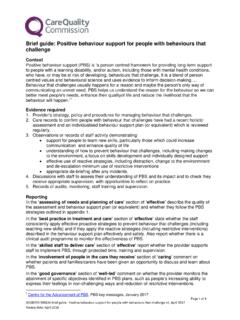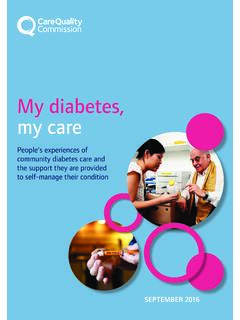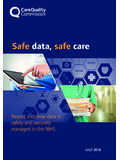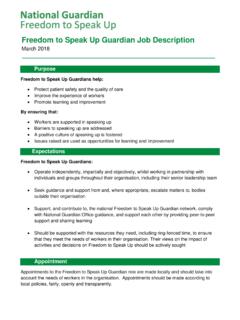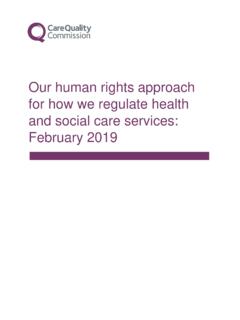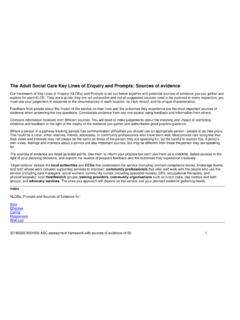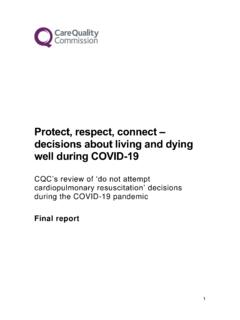Transcription of Brief guide: restraint (physical and mechanical)
1 Brief guide : restraint ( physical and mechanical ) Context Latest guidance from the Department of Health (DH), Positive and Proactive Care, places an increasing focus on the use of preventive approaches and de-escalation for managing behaviour that services may find All restrictive interventions should be for the shortest time possible and use the least restrictive means to meet the immediate need based on the fundamental principles in Positive and Proactive Care. This is supported by the 2015 Mental Health Act Code of Practice which states that unless there are cogent reasons for doing so, there must be no planned or intentional restraint of a person in a prone position .2 NICE guideline NG10: Violence and aggression also recommends avoiding prone restraint , and only using it for the shortest possible time if We recognise that the use of mechanical restraint may be considered to be the least restrictive intervention in some specific cases, and may present less risk to the individual than the alternative of prolonged manual restraint or transfer to a more restrictive setting.
2 This could provide a valid reason for using mechanical restraint in an emergency or unplanned interventions, as well as planned interventions. However, providers should clearly document that any mechanical and physical interventions were considered by a group wider than just the service to assess whether this was the least restrictive option which was in the best interests of the person, and that there were no less restrictive alternatives which were appropriate and proportionate to the risks posed. In line with Positive and Proactive Care, providers should have a policy on the use of restraint and a restrictive intervention reduction programme, for which the board is accountable. Use of all restraint , including any use of mechanical restraint , should always be in line with this policy, and any staff should be appropriately trained. All cases of mechanical restraint should be reported to the trust Evidence required 1.
3 Examine the return from the provider information request about all uses of restraint for each service area/ward. If there are frequent uses of restraint is it being used frequently for one or two people or applied to many people a few times? 2. When visiting a service area/ward, with a particular focus on wards with high use of restraint , record on the evidence tables your findings about the experience of people who have been subject to restraint . Check de-escalation practice. Enquire about staff training in modes of restraint that are in line with best practice and staff awareness of latest guidance on restraint . Review the quality of reporting of incidents and of de-briefing for staff. 3. When examining care records, check that care plans follow the principles of positive behaviour support ( having a focus on preventive strategies, including de-escalation, whether or not this is referred to as positive behaviour support ), evidence patients preferences for future restraint , and the quality of recording for incidents of restraint .
4 1 2 3 4 20180404 900803 Brief guide restraint - physical and mechanical v14. When interviewing the director of nursing, hospital manager or other executives, ask about the provider restrictive intervention reduction programme; the reporting of restraint to commissioners and others. This includes returns to national datasets such as the Mental Health and Learning Disabilities Dataset (MHLDDS) and whether they are aware of the hotspots for restraint , for example increased use, incidents relating to restraint . 5. If you find that any form of mechanical restraint is being used, request details of board-level agreement and documents which show evidence that this was deemed the least restrictive intervention. 6. Review training records to check all team members have been trained in the relevant physical intervention package for that setting, or had a refresher training session in the last 12 months.
5 Discuss with team members the values that were expressed in the training to identify whether there was a focus on avoiding physical interventions, and ascertain how confident the staff feel in using the techniques taught. 7. Review processes for debrief. These should include plans for staff and people who receive support. Look for documentation of debrief. 8. Where possible, ask people about their experiences of being restrained. See appendix A for additional considerations. Reporting 1. In the assessing and managing risk to patients and staff section of safe state: Exactly how many restraints there were on each ward/service (over the past six months) and how many of these were in the prone position. Whether the provider can justify this on exceptional circumstances grounds. Findings about staff awareness of best practice and the quality of de-escalation and application of the principles of positive behaviour support.
6 The percentage of ward/service staff who have had training in best practice restraint . 2. Under reporting incidents and learning from when things go wrong in safe state your findings on the reporting of incidents of restraint and of staff de-briefings. 3. Under good governance in well-led report on the quality of the provider restrictive intervention reduction programme, restraint reduction plans and audit, the quality of reporting to commissioners and processes for ensuring appropriate staff training. Policy position Providers should act within the principles set out in Positive and Proactive Care, and use all restrictive interventions in line with the MHA Code of Practice 2015, Mental Capacity Act 2005, Human Rights Act 1998 and the common law. Link to regulations Overuse of restraint and prone restraint links to regulation 13(4)(b).
7 If staff are not recording restraint properly, regulation 17(2)(c) in relation to record keeping applies (there are no specific regulations on recording information about restraint ). If training on restraint is inadequate, this may be assessed under regulation 18(2)(a). 20180404 900803 Brief guide restraint - physical and mechanical v1 If de- escalation or positive behaviour support (or equivalent) is not being used proactively, this is very likely a breach of 13(4)(b). If there is no provider-wide strategy to reduce restrictive interventions including restraint , this links to regulation 17(1)(2)(a)(b) and (f). Appendix A: Additional considerations when collecting evidence Inspection teams should check that: All users at risk of being exposed to a restrictive intervention have an individualised care plan or behaviour support plan, aimed at reducing the need for the use of restraint .
8 Where possible the person the plan is for should be involved, and in all circumstances the plan should be person-centred. Where restraint is necessary, providers use techniques and approaches which are the least restrictive, pose the least risk to service users and staff, and ensure that staff are adequately trained and supported in these. Training in restraint techniques should have a clear focus and primary purpose in teaching person centred approaches to avoiding situations where restraint is required. Where there are any incidents of physical restraint , the multidisciplinary team reflect on them and think what can be done to prevent similar incidents both for the service user in question and the client group as a whole. There should be a clear debrief process for the team after an incident and also for the person who has been restrained.
9 If prone restraint is used, the provider is able to state the exceptional circumstances that justify this and the arrangements for seeking immediate medical attention. This should all be clearly documented in individual care plans, and subject to regular monitoring and review. Any form of mechanical restraint used for a patient is agreed at board level, and it is clearly documented how this has been deemed the least restrictive option for that person and why alternative approaches would not be suitable for them. Providers have a transparent policy on the use of restrictive interventions, with an overarching restrictive intervention reduction programme with board-level lead. The provider should report to commissioners and in the quality, on use of restrictive interventions, progress of the reduction programme and on training and development.
10 20180404 900803 Brief guide restraint - physical and mechanical v1 Appendix B : Definitions and principles The Mental Capacity Act 2005 (MCA) defines restraint as when someone uses, or threatens to use force to secure the doing of an act which the person resists, OR restricts a person s liberty whether or not they are resisting . Section 6 of the MCA states that restraining people who lack capacity will only be permitted if, in addition to it being in their best interests, the person taking action reasonably believes that it is necessary to prevent harm to the person. In addition, the amount or type of restraint used, as well as the amount of time it lasts, needs to be proportionate to the likelihood and seriousness of potential harm. Definitions of the types of restraint are outlined below. physical restraint : a ny direct physical contact where the intention of the person intervening is to prevent, restrict, or subdue movement of the body, or part of the body of another person.
